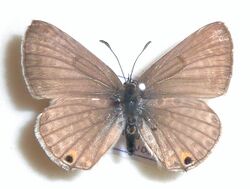Biology:Lepidochrysops plebeja
From HandWiki
Revision as of 11:29, 17 October 2021 by imported>JOpenQuest (fix)
Short description: Species of butterfly
| Twin-spot blue | |
|---|---|

| |
| Scientific classification | |
| Domain: | Eukaryota |
| Kingdom: | Animalia |
| Phylum: | Arthropoda |
| Class: | Insecta |
| Order: | Lepidoptera |
| Family: | Lycaenidae |
| Genus: | Lepidochrysops |
| Species: | L. plebeja
|
| Binomial name | |
| Lepidochrysops plebeja (Butler, 1898)[1]
| |
| Synonyms | |
| |
Lepidochrysops plebeja, the twin-spot blue, is a butterfly of the family Lycaenidae. It was described by Arthur Gardiner Butler in 1898. It is found in Botswana, Zimbabwe, Mozambique, Malawi, Zambia and South Africa .
The wingspan is 35–43 millimetres (1.4–1.7 in) for males and 38–45 mm for females. Adults are on wing from November to January. There is one generation per year.[2]
The larvae feed on Lantana rugosa. Third and later instar larvae feed on the brood of Camponotus niveosetus ants.
Subspecies
- Lepidochrysops plebeja plebeja (northern Eastern Cape, KwaZulu-Natal, north-western Free State, Gauteng, Mpumalanga, Limpopo, North West and Northern Cape)
- Lepidochrysops plebeja proclus (Hulstaert, 1924)
References
- ↑ Lepidochrysops at Markku Savela's Lepidoptera and Some Other Life Forms
- ↑ Woodhall, Steve (2005). Field Guide to Butterflies of South Africa. Cape Town, South Africa: Struik. ISBN 978-1-86872-724-7.
Wikidata ☰ Q6527563 entry
 |

